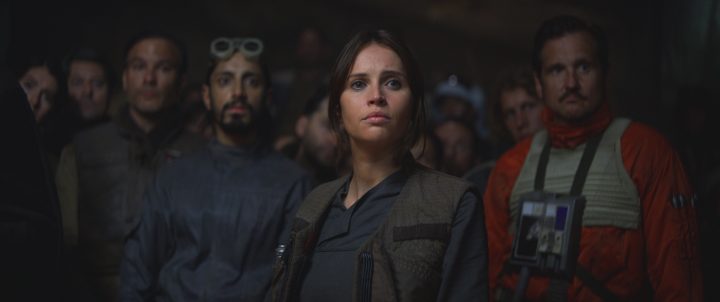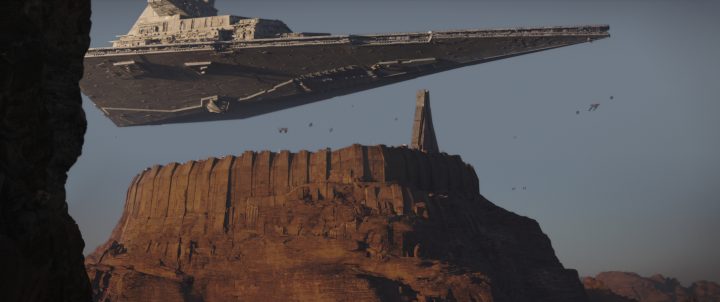I am not as invested in the Star Wars universe as most fans are. I have yet to watch a single episode of The Clone Wars, Star Wars Rebels or even Lego Star Wars; I have not read any of the novels published by Del Rey Books nor the comics published first by Dark Horse Comics and now by Marvel. The movies remain my one and only entry point. I share with most fans their contempt for the Lucas-directed prequels, for the Ewoks and for Jar Jar Binks. And, like them, I believe that The Empire Strikes Back is still the best film of the original trilogy. I also cheered during and even breathed a deep sigh of relief after seeing The Force Awakens, J.J. Abrams’ energetic reboot of the series even though, let’s face it, it’s basically a remake of A New Hope. And here we are, exactly one year after that entry hit the screens, with the first of several stand-alone stories designed to feed the hunger for all things Star Wars while we wait for the remaining chapters of the new trilogy to be made and released.
For there is no doubt that these stand-alone stories are designed to further milk the Star Wars cash cow. However, Rogue One: A Star Wars Story is a worthy addition to the canon. Directed by British filmmaker Gareth Edwards (Monsters, the 2014 Godzilla) and written by Chris Weitz (A Better Life) and Tony Logan (The Bourne Trilogy), Rogue One raises the bar, visually and narratively, for the next film in the saga, more so than The Force Awakens did. Like director Irvin Kershner and writers Lawrence Kasdan and Leigh Brackett in The Empire Strikes Back before them, Edwards, Weitz and Gilroy expand on the universe created by George Lucas, painting it in shades of grey and other murky colors. Even though it is an actual prequel to A New Hope, the trio is not totally beholden to the franchise’s core optimism. Their characters are soldiers, most of them expendable, who embrace a cause or mission for personal reasons, paving the way for the heroic deeds of others. سلوتس اون لاين

It’s no state secret that Rogue One tells the story of how a small group of rebels stole the blueprints to the first Death Star and that Edwards has dispensed with the traditional opening crawl that sets up the story as well as John Williams’ beloved fanfare-like theme (the score is written by the prolific Michael Giacchino). The film opens in a volcanic planet where Imperial scientist Galen Erso (Mads Mikkelsen) has set up shop as a farmer after turning his back on his Fascist bosses. The Empire comes knocking at his door and Galen is taken away by force to finish what he started with the Death Star, leaving behind a wife shot dead by a Death Trooper, and a traumatized daughter in hiding.
Fast forward to more than 20 years later: that daughter, Jyn (Felicity Jones) is now imprisoned in a labor camp for crimes against the Empire. She is rescued by Rebel leader Cassian Andor (Diego Luna) and his sarcastic mate K-2SO, a reprogrammed Imperial android voiced by Alan Tudyk (his dialogue, one of the film’s many highlights, gives good old C3PO a run for his money). كازينو وليام هيل A deserting Imperial pilot by the name of Bodhi Nook (Riz Ahmed) carrying an important recording from Galen has been captured in the planet Jedha by a fringe guerrilla group led by Clone Wars veteran Saw Gerrera (Forest Whitaker), the man tasked by Galen with protecting Jyn. The Rebel Alliance wants her to convince Saw to turn over the recording to them since it contains vital information about the Death Star. The search for Galen and the blueprints lead Jyn, Cassian, K-2SO, Bodhi and the two outcasts they have picked along the way —blind warrior-priest Chirrut Imwe (the always reliable Donnie Yen, injecting the film with a good dose of Hong Kong martial arts flair) and best mate and bodyguard Baze Malbui (Jiang Wen)— from the rainy Imperial outpost of Eadu to the Empire’s military base in Scarif where the plans are being kept, leading to a rousing, gripping and emotionally devastating third act.
In between action sequences, we are given a taste of the internal strife that drives members of the Rebel Alliance to inaction (and in some cases to making some morally dubious decisions) and the power struggle inside the Empire. ربح فلوس The politics here are not as complex, or as dull, as those presented in Lucas’ prequels. To the contrary, it shows that, as in any revolution, the Rebel Alliance’s ideals and motivations can be compromised while it paints the Empire as a cesspool of piranhas ready to devour each other.

Given that this is a prelude to A New Hope, the appearance of some key characters was inevitable, particularly Darth Vader who (once again voiced by James Earl Jones’ mellifluous voice) is back in all his ruthless, deadly glory (the film’s final minutes is a showcase for Vader’s mercilessness). One actor is literally brought back from the dead via CGI to take over command of the Death Star from the film’s new villain Orson Krennic (Ben Mendelsohn): the late, great Peter Cushing as Grand Moff Tarkin, voiced by an uncredited actor who comes quite close to imitating Cushing’s unique cadences. His appearance is at first jarring; it almost threatens to pull you out of the film. But you eventually get used to it and understand the reasoning behind this creative choice.
Rogue One is, in effect, a war movie where very death carries means something, where every laser blast is deadly. Yes, it borrows motifs and ideas from such films as The Dirty Dozen. But not since Paul Verhoeven’s Starship Troopers (which poked fun at the military’s Fascist tendencies) has a science-fiction film, much less a franchise-driven one, depicted war in such in-your-face terms. Granted, the bloodshed is kept to a minimum (we are not talking about Hacksaw Ridge-like mutilations). But as shot by The Hurt Locker cinematographer Greig Fraser, these scenes, in their combination of hand-held camera and CGI effects, feel immediate, organic and immersive. We are no longer dealing with anonymous rebel fighters and stormtroopers falling dead; each explosion, each flying body, has weight. Hope may be the force that feeds a rebellion, but the sacrifice and bravery of a few men and women are its true fuel. That notion alone makes of Rogue One one of the most sober entries in the saga.

Yet, there is majesty in this world as well. There are shots here that have the same sense of grandeur as those of any major epic: a high angle shot of the fallen statue of a Jedi in a desert; an Imperial carrier floating above a city; the Death Star’s ray piercing through a planet’s crust; the tropical island where the Imperial military base is located. They could all have easily come out of a David Lean film, had he ever considered shooting a science-fiction film.
Much has been made of Rogue One’s and The Force Awakens’ diverse cast. But, if you take into consideration the saga’s narrative chronology, I would argue that such diversity plays a more incisive role in Rogue One by unconsciously showcasing how the contributions of women and people of color to any war effort have fallen to the wayside in the historical telling of these tales while the contributions of white men are widely celebrated in books, songs and movies. That Edwards, Weitz and Logan have, deliberately or not, introduced this idea in a piece of entertainment should not be underestimated. The point may not be belabored but the evidence is in the pudding. Smart commercial filmmaking of this kind should be embraced. There should be more of it.